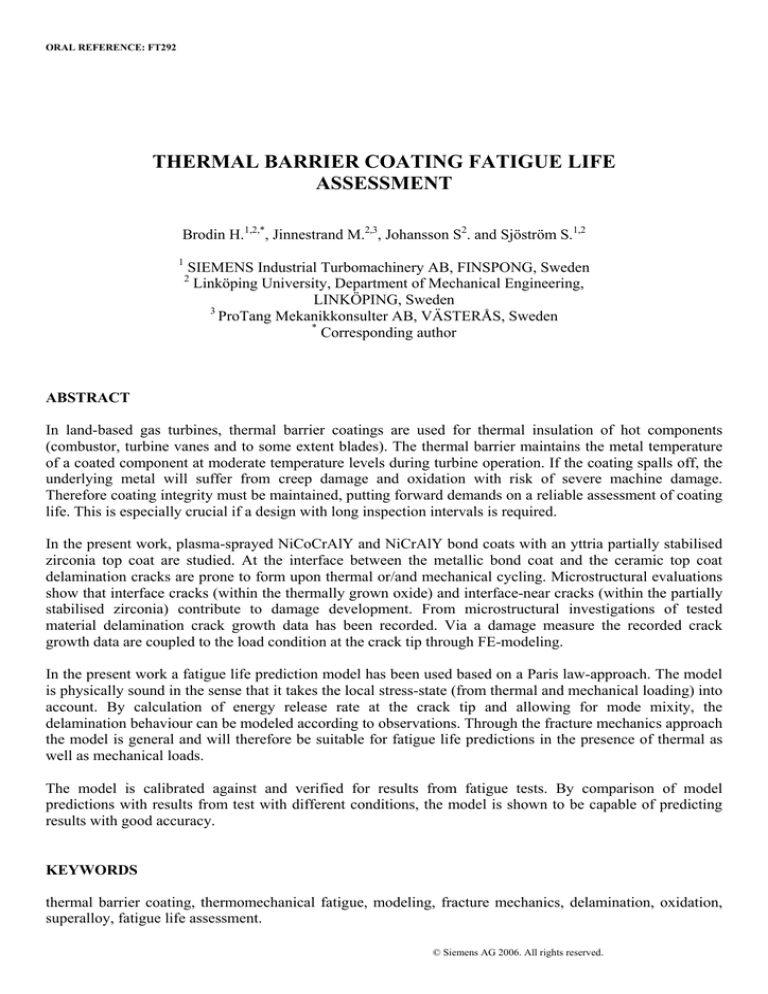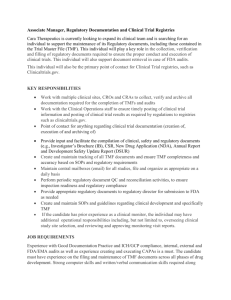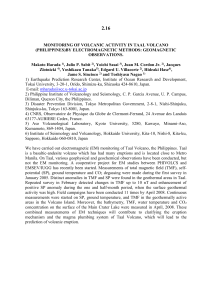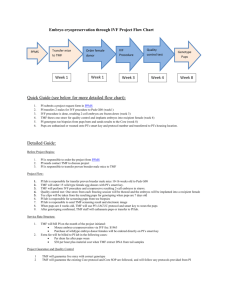
ORAL REFERENCE: FT292
THERMAL BARRIER COATING FATIGUE LIFE
ASSESSMENT
Brodin H.1,2,*, Jinnestrand M.2,3, Johansson S2. and Sjöström S.1,2
1
SIEMENS Industrial Turbomachinery AB, FINSPONG, Sweden
Linköping University, Department of Mechanical Engineering,
LINKÖPING, Sweden
3
ProTang Mekanikkonsulter AB, VÄSTERÅS, Sweden
*
Corresponding author
2
ABSTRACT
In land-based gas turbines, thermal barrier coatings are used for thermal insulation of hot components
(combustor, turbine vanes and to some extent blades). The thermal barrier maintains the metal temperature
of a coated component at moderate temperature levels during turbine operation. If the coating spalls off, the
underlying metal will suffer from creep damage and oxidation with risk of severe machine damage.
Therefore coating integrity must be maintained, putting forward demands on a reliable assessment of coating
life. This is especially crucial if a design with long inspection intervals is required.
In the present work, plasma-sprayed NiCoCrAlY and NiCrAlY bond coats with an yttria partially stabilised
zirconia top coat are studied. At the interface between the metallic bond coat and the ceramic top coat
delamination cracks are prone to form upon thermal or/and mechanical cycling. Microstructural evaluations
show that interface cracks (within the thermally grown oxide) and interface-near cracks (within the partially
stabilised zirconia) contribute to damage development. From microstructural investigations of tested
material delamination crack growth data has been recorded. Via a damage measure the recorded crack
growth data are coupled to the load condition at the crack tip through FE-modeling.
In the present work a fatigue life prediction model has been used based on a Paris law-approach. The model
is physically sound in the sense that it takes the local stress-state (from thermal and mechanical loading) into
account. By calculation of energy release rate at the crack tip and allowing for mode mixity, the
delamination behaviour can be modeled according to observations. Through the fracture mechanics approach
the model is general and will therefore be suitable for fatigue life predictions in the presence of thermal as
well as mechanical loads.
The model is calibrated against and verified for results from fatigue tests. By comparison of model
predictions with results from test with different conditions, the model is shown to be capable of predicting
results with good accuracy.
KEYWORDS
thermal barrier coating, thermomechanical fatigue, modeling, fracture mechanics, delamination, oxidation,
superalloy, fatigue life assessment.
© Siemens AG 2006. All rights reserved.
INTRODUCTION
In land-based and air-borne gas turbines thermal barrier coatings (TBC) have been used for some twentyfive years [1] as an insulator for load-carrying hot components from the hot oxidative environment in
combustor and turbine. Due to the low thermal conductivity, ceramic, normally yttria partially stabilised
zirconia (YPSZ), is used as a top coat (TC) together with a metallic bond coat (BC). Here the TC will act as
the thermal insulator while the BC will provide adherence for the ceramic outer layer. For oxidation
resistance the bond coat is an aluminium-rich alloy based on either nickel or cobalt [2]. In industrial
applications the TC is used in a thickness from 300µm up to approximately two millimetres.
During service the material will change its behaviour. The top coat will sinter and change mechanical
properties [3] as well as thermal conductivity [4]. Also oxidation of the bond coat and microstructural
changes during high temperature exposure due to enrichment/depletion (diffusion and oxidation) of elements
will alter the material properties [5-7]. From previous studies it is well-known that high temperature
exposure, thermal and mechanical loading will increase the residual stress level at the interface between
ceramic and metal. Damage, in terms of interface delamination, will with time develop within the material
system [8-10]. Eventually the delamination damage will be so severe that the material can buckle and large
pieces of the TC can flake off. A consequence of coating loss will be local overheating of the underlying
metal with obvious risk of severe oxidation and also creep damage if the component is mechanically
stressed.
In order to use a gas turbine as economically and efficiently as possible, it is desirable to maximise the time
between inspections and overhaul with maintained mechanical integrity. Therefore different tools are used
for assessment of spallation fatigue life for thermal barrier coatings. The present paper will deal with a
method proposed by Brodin and Jinnestrand [11. 12]. The model is based on a fracture-mechanical approach
supported by observations from thermal and mechanical testing of TBC systems.
MATERIAL SYSTEM
The material used in the present study is an air plasma sprayed thermal barrier coating system. As substrate
material Haynes 230 from Haynes International is used. In the present study, substrate material has been
manufactured to tubular specimens according to Figure 1. By the APS process a thin TBC system has been
applied to bond coat and top coat thicknesses of 150µm and 350µm respectively. Chemical compositions for
substrate, bond coat and top coat are given in Table 1, and the coating microstructure is shown in Figure 2.
Figure 2 also indicates substrate (S), BC and TC. The picture also indicates the location of the thermally
grown oxide (TGO) that will form at the interface between BC and TC during high temperature exposure.
Due to the high aluminium content of the bond coat, the interface oxide is mainly alumina. For the present
coating system the BC/TC interface roughness has been measured to be Ra=8µm.
TABLE 1
COMPOSITIONS OF SUBSTRATE AND COATINGS IN THE PRESENT MATERIAL SYSTEM (VALUES IN WT%).
Substrate
BC
TC
Ni
Bal.
Bal.
-
Fe
<3
-
Cr
22
17
-
W
14
-
Co
<5
23
-
Si
0,4
-
Mn
0,5
-
Ti
-
Al
0,3
12,5
-
Mo
2
-
B
0,015
-
C
0,1
-
Y
0,5
ZrO2
7
Y2O3
Bal.
EXPERIMENTAL PROCEDURE
Testing of TBC-coated cylindrical specimens has been done in terms of in-phase (IP) and out-of-phase (OP)
TMF testing. For the purpose a servohydraulic test rig has been used. The rig was a 160kN MTS test rig
equipped with an INSTRON 8800 controller aimed for multiaxial testing. Gripping of the test specimen was
done by threaded grips equipped with a centering cavity for accurate positioning of the test specimens. By
© Siemens AG 2006. All rights reserved.
strain gauge instrumentation of a dummy specimen the grips were aligned so that at maximum load the bend
strain reading in any direction did not exceed 2% of the total axial strain reading. Tests were run in straincontrolled operating mode. Applied mechanical strains were measured by an axial extensometer with a
gauge length of 12.5mm.
Figure 1: TMF specimen design. Hatched region indicates TBC-coated area, GL = 40 indicates heated
specimen length.
TC
TGO (TC/BC interface)
BC
S
100µm
Figure 2: APS TBC system used for spallation life model calibration and TMF testing.
Through a hole in the grips, compressed air was permitted to cool the interior of the test specimen during
parts of the thermal cycle so an accurate thermal gradient could be created through metal and TBC system.
The thermal load was provided via a resistance heated 5kW split-furnace. Specimen temperature during
testing was done by using a type S thermocouple with wire dimension 0,25mm strapped onto the TBC
surface by a platinum wire. Axial and circumferential temperature gradients along the test section were
measured in advance and found to be ∆Taxial = 15°C and ∆Tcirumf = 20°C.
Definition of failure must in this case be split into two alternatives, “classic” fatigue cracks and interface
cracks that will cause spallation. The former crack type is easily detected through standard methods, such as
© Siemens AG 2006. All rights reserved.
© Siemens AG 2006. All rights reserved.
the load drop criterion when testing in strain-controlled operating mode. Here the criterion was set to a load
drop of 20% calculated from the mid-life cycle. The delamination damage case is not easily covered by
standard procedures. However, in the present study it turned out that any large delamination will cause the
ceramic TC to cease following the movement of the substrate. For a given axial mechanical strain the load
will increase since strain measurement is done on the TC and not the loaded metal. Accordingly, the system
can be set to stop if a given maximum load level is exceeded during operation in strain-controlled mode.
This method was used in the present study for estimating when a large TBC spallation damage occurred. The
TMF cycle used in the present work is schematically shown in Figure 3. For the present tests the cycle time
was 1500s. Both out-of-phase (OP TMF) and in-phase (IP TMF) load cycles were adopted in testing as
shown in Figure 3.
Figure 3: TMF IP and OP cycles adopted for present verification testing.
DAMAGE EVALUATION
During thermal and/or mechanical loading of a thermal barrier coating system, several phenomena can be
isolated that contribute to coating damage. In the case of TMF loading, TBC and substrate damage can take
place in terms of initiation and growth of “classic” fatigue cracks with crack growth normal to the surface
through the coating into the substrate material. In addition, formation and growth of cracks parallel to the
surface of a TBC system can take place due to the difference in physical and mechanical properties of the
ceramic TC and the metallic BC in the TBC system. Due to the presence of stresses normal to the surface of
a TBC aggregate, cracks parallel to the surface can also initiate and grow at the interface between top- and
bond coat. It is not easy to design a test where a single interface delamination crack can be studied as done
for crack growth testing of a metallic material, for instance with the co-called CT test. Instead it is necessary
to study the development of many cracks initiating and growing simultaneously at the interface. With this in
mind we have introduced a damage parameter D, defined as
D=
∑l
i
TGO
i
TGO/TC
+ ∑ l TC
j + ∑ lk
j
k
L
(1)
TC
where liTGO designates individual delamination cracks i extending only in the thermally grown
TGO/TC oxide, lj
represent
designates delamination cracks j with growth only in the ceramic top coat and lk
delamination cracks with part of the growth at the interface and part in the top coat. L is the total interface
length investigated.
Since Eqn (1) relates D directly to crack lengths, we can express damage growth directly as
dD
= f ( stress state at interface )
dN
(2)
where N is number of cycles. It is natural to see the damage development measure dD/dN as an average
value for damage in discrete time steps, since the measure is derived from average crack lengths. In each
time step are a number of cracks analysed, categorised and measured giving a statistical basis even for a
limited set of tests.
The general damage development in a TBC system is shown in Figure 4, where four regions are indicated. In
region I no large damage development takes place. After some time at high temperature, the degree of
oxidation at the interface will increase and cracks are formed in the thermally grown oxide. In this stage the
crack growth rate is fast as indicated in region II. Region III shows a period of rather stable damage level,
indicated by a plateau with very low crack growth rate. In later stages in the delamination fatigue life (stage
IV), the damage growth rate increases again due to coalescence of existing cracks, leading to the final
spallation, i.e. loss of the thermal barrier. It is convenient to define TBC failure as the transition from region
III to region IV, where stable crack growth behaviour ceases to exist.
Figure 4: Schematic representation of TBC delamination fatigue damage development. A fatigue life
limit is defined at the transition from slow crack growth (region III) to final failure (region IV),
in the present case D = 0,85.
TBC SPALLATION LIFE MODEL
A method for prediction of TBC spallation fatigue life has been proposed by Brodin and Jinnestrand [11,
12]. The model, based on a fracture mechanical approach, is a modification of Paris law with respect to
incorporation of mixed mode crack growth. In Paris law, the classic stress intensity is first replaced by the
energy release rate,
da
n
= C (λ∆G )
dN
(3)
where λ is a function that describes the reduction of the crack growth rate during mixed mode crack growth
compared to mode I crack growth. The measured average interface roughness is used for geometry
modeling. As a basis for the development of the present λ-function a previous description by Hutchinsson
and Suo has been used [13]. According to Eqn. 2 it is convenient to leave the classic approach for crack
© Siemens AG 2006. All rights reserved.
© Siemens AG 2006. All rights reserved.
growth representation and move away from the da/dN measure and switch to a damage development
approach dD/dN. Then Eqn. 3 can be written as
dD
n
= C1 (λ ∆G ) 1
dN
(4)
where C1 and n1 are Paris law fitting parameters and λ can be described according to
m
⎛2
⎞
−1 ⎛ K II ⎞ ⎟
⎜
⎟⎟
λ = 1 − (1 − λ0 ) tan ⎜⎜
(5)
⎜π
KI ⎠ ⎟
⎝
⎝
⎠
where λ0 and m are fitting parameters. KI and KII are stress intensity factors for pure crack opening and crack
shear modes, respectively. From (4) the fatigue life to TBC spallation can be integrated,
N = N0 +
Dcr
∫
D0
dD
⎛
⎞
∆K II
, K⎟⎟
f ⎜⎜ ∆G,
∆K I
⎝
⎠
(5)
where N0 is a parameter describing the initial defect state of the TBC aggregate, D0 and Dcr represent initial
and final damage state. The model has been calibrated to thermal fatigue data [14] as seen in Figure 5.
Figure 5: Calibration of fatigue life model from thermal fatigue data, after Brodin and Jinnestrand [12].
RESULTS
Fatigue life results from TMF tests are presented in Table 2. In the graph a comparison is also made with
thermal fatigue test results.
TABLE 2
RESULTS FROM TMF (VERIFICATION DATA) AND THERMAL FATIGUE TESTS
(CALIBRATION DATA) FOR THE PRESENT MATERIAL SYSTEM.
Type
In-phase
Out-of-phase
Thermal fatigue
∆εmech
0,48
0,48
-
R
0
0
-
∆T [°C]
750
750
1000
Cycle time [s]
1500
1500
4200
Nspall
400 OBS ungef.
250 OBS ungef.
900 OBS ungef.
From the results it is clear that an OP TMF load is more detrimental for TBC spallation than an IP TMF
load. It is also clear that the addition of a mechanical load is detrimental to the spallation life of the material
system, since the fatigue life for both IP TMF and OP TMF is inferior to that of a pure thermal cycle even
though the thermal load (temperature range) is lower in the TMF cycles used than in the thermal cycling test.
A fractographic investigation of the cycled TMF test specimen has been made and the results are shown in
Figure 6 (OP TMF) and 7 (IP TMF).
OP TMF
Fractogreaphy
IP TMF
Fractogreaphy
Dessa har jag ej hämtat hem
från LiTH ännu
Dessa har jag ej hämtat hem
från LiTH ännu
Figure 6: TMF OP fractography showing
delamination damage at the interface
between TC and BC.
Figure 7: TMF IP fractography showing
delamination damage at the interface
between TC and BC.
Both OP and IP TMF show signs of delamination damage in the interface between TC and BC. However, in
the case of IP TMF substrate fatigue cracks are also evident. These cracks, however, have not caused the
specimen failure.
A comparison between actual spallation life results and fatigue life assessments for IP and OP TMF has been
performed, where energy release rate, mode I and mode II stress intensity factors have been calculated.
Predicted stress intensity factors KI and KII with an applied mechanical stress of 200, 0 and –200 MPa (OP
TMF, 4µm TGO) are shown in Figure 8. These values are then used as reference values for prediction of
crack growth rates to be used in the fatigue life model of Eqn.(5). A comparison between results and the
predictions is shown in Figure 9.
2.5
KII 200 MPa
K
K
KII 0 MPa
K
KII -200 MPa
K
KII
II 200 MPa
K
KII
II 0 MPa
K
KII
II -200 MPa
Ki [MPa √m]
2
1.5
1
0.5
0
0
0.2
0.4
0.6
damage parameter D [-]
0.8
1
Figure 8: Calculated stress intensity factor levels corresponding to OP TMF load cases with 4µm TGO.
© Siemens AG 2006. All rights reserved.
interface damage parameter D [-]
1,0
0,8
0,6
0,4
Experimental data of cycle
Corresponding model prediction
prediction TMF IP
prediction TMF OP
experimental data TMF OP
experimental data TMF IP
0,2
0,0
0
200
400
600
cycles [-]
800
1000
1200
Figure 9: Comparison between test results (solid lines) and model predictions (dotted lines).
OP results are shown in blue, IP results in red.
DISCUSSION
Test procedure, failure detection
During testing in a split-furnace it is not simple to use visual methods for inspection of TBC delamination
damage. Therefore, the present TMF test series made use of the fact that the load level changed when a large
spallation was present within the extensometer gauge length. If a large delamination crack is present within
the extensometer gauge length the response to a requested strain change will be lower than for a
homogeneous TBC system, since the TC does not follow the substrate movement when cracks parallel and
perpendicular to the surface are present. Accordingly, a gradual increase in load range for a given strain
range will imply that a growing delamination crack is present. After growth and coalescence of small cracks
it is a risk that an excessive large deformation can be introduced into the test specimen during TMF cycling.
The fatigue life would then be shortened in comparison to what the model would predict, since the load is
kept constant during spallation fatigue life modeling.
Due to the furnace design the heated zone was approximately three times the extensometer gauge length.
However, heat transfer from the heated region to cold sections caused the temperature to drop outside the
extensometer gauge length. Therefore delamination cracks are not detected over the entire heated surface.
However, from microscopy observations it appears as if the interface within the extensometer gage length is
representative for the entire failure and that the results are reliable from this point of view.
Differences in fatigue life, IP vs OP loading
Jinnestrand and Sjöström performed an FE-analysis of the correlation between stress state, TBC interface
geometry, oxidation and thermal cycling [15]. From this work it is clear that the highest tensile delamination
stress in a TBC system occurs at low temperature after exposure to the environment, allowing for a TGO to
form at the interface.
In the present study with OP and IP TMF loading, the effect of a tensile stressed interface at low temperature
is higher in OP TMF than in the IP TMF load case, since a high tensile load is applied at Tmin during the OP
TMF cycle. In the IP TMF case, the situation is different; due to an unloaded interface at low temperature
the fatigue life is expected to increase. However, some damage development is bound to take place at Tmax
during IP TMF cycling since oxidation of open cracks and also creep damage are likely to play important
roles at temperatures in the range of 1000°C. The trend seen in the results is, however, consistent with the
previous findings; detrimental damage from a spallation point of view is introduced at low temperature,
where interface crack growth is predicted due to thermally induced stresses.
© Siemens AG 2006. All rights reserved.
Difference in Fatigue Life Response Between TMF and TCF Data
TMF fatigue life predictions and measurements are consistent; in comparison to measured thermal cyclic
data the fatigue life is reduced. This is valid for OP TMF as well as for IP TMF results. For IP, the expected
fatigue life is somewhat shorter than for the corresponding thermal cycle. It is reasonable to state that the
fatigue life will be shortened when a mechanical load is added to the thermal load previously discussed. Also
the fact that cracks will form and grow within the substrate material causes the stress-state in the TBC to
change.
Measurement and Calculation Differences
The present fatigue life model has been calibrated against fatigue life data from thermal fatigue tests. As
these tests mainly cause fatigue crack growth at low temperature, no or little effect from creep damage and
high temperature crack growth is incorporated in the existing model calibration data or the model itself. If
the model is to predict an IP TMF load accurately, further calibration test series need to be performed where
cracks are allowed to grow at high temperature under oxidative conditions. The model does not at present
take high temperature effects into account and will therefore overestimate the fatigue life for an IP TMF case
in comparison to what is seen in the OP TMF case.
Surface Roughness
The present fatigue life model assumes an average surface roughness for calculations of stress intensity
factors and energy release rate. In a real TBC system the surface roughness is of course not constant
throughout the entire coating. Any large asperity will have an impact on initiation of cracks. Around large
asperities the stress state will differ from an “average situation” and, accordingly, the crack growth rate will
be influenced by the locally more severe stress-state. The fatigue life model will therefore be nonconservative when not taking a spread in properties into account. However, recent studies [16] show that the
effect of changed stress-state (in the particular case at a free TBC edge) only extends a short distance, in the
order of 1mm away from the highly stressed location. Therefore the error made when not taking a real
interface into account is not of great significance.
Temperature Distribution
The model is, according to the present results, shown to be sensitive to variations in temperature. In the
present case, the temperature is measured on the TBC surface. Therefore the true temperature at the TC/BC
interface is not captured. In the present case a comparison with reference measurements will be needed.
Therefore an uncertainty is introduced into the calculations. In Figure 9 this is shown as a span in spallation
fatigue life Nspall in the comparison with measured data.
CONCLUSIONS
TMF testing has been done on an air plasma sprayed thermal barrier coating system. Both in-phase and outof phase tests have been performed and the fracture analysed. In the present case the failure appeared to be
due to delamination crack growth at the interface between the metallic bond coat and the ceramic top coat
for the out-of-phase load. Fatigue testing with temperature cycling and mechanical loading in-phase reveals
damage contributions from delamination cracking at the interface together with fatigue crack growth in the
substrate material.
A fracture-mechanics based spallation fatigue life model has previously been proposed for thermal barrier
coating life assessment in industrial gas turbines. The model, calibrated against thermal fatigue tests, has
been used to predict the fatigue life of the IP and OP TMF tests. The results can be summarised as:
•
•
•
A combination of the thermal and mechanical loading applied gives a shorter fatigue life than the
thermal cycle used during calibration testing. This is seen both in test results and in fatigue life modeling.
Out-of-phase loading gives a shorter fatigue life than in-phase TMF loading. This is explained by tensile
loading at low temperature resulting in high delamination stresses at the interface.
The fatigue life model can predict out-of-phase TMF more accurately than in-phase TMF loading. An
explanation is found in the fact that the calibration data are retrieved from thermal fatigue testing where
© Siemens AG 2006. All rights reserved.
•
the material system is unloaded at high temperature. At the maximum temperature only oxidation takes
place in the calibration tests. However, in the TMF in-phase test cycle a mechanical load is
superimposed at Tmax resulting in high temperature crack growth. TMF in-phase crack growth will be
influenced by oxidation of the crack tip during crack opening. Bond coat and interface creep damage will
also influence the result.
From the accuracy for out-of-phase TMF predictions, the proposed model will be able to accurately
predict critical cases representative for gas turbines such as hot spots.
ACKNOWLEDGEMENTS
The authors would like to acknowledge the Swedish Energy Administration for financial support through
grant KME-706/106.
REFERENCES
Denna del är ej uppdaterad.
[1]
[2]
[3]
[4]
[5]
[6]
[7]
[8]
[9]
[10]
[11]
[12]
[13]
[14]
[15]
[16]
Reymann, H., “MCrAlY deposition by HVOF: A suitable alternative to LPPS” In: Turbine
Forum, Advanced Coatings for high temperatures, Nice Port St Laurent, France, April 17-19,
(2002).
Ref som behandlar varianer av MCrAlY och NiAl.
Åldringens inverkan på mek egenskaper. Mats ref.
Karlsson, F., “???”, Technical report, Linköping university, (200?).
Brodin, H. and Eskner, M., “xxx – paper I”, Surf. Coat. Technol., xxxxxxx.
Oxidation/mikroistruktur BC.
Oxidation – egenskaper:BC.
Residual stresses in TBC
Delamination/spallation (mitt?)
Buckling, Evans
Br DR
Ji DR
Hutchinsson Suo
Brodin, H. and Li, X.H., “xxx”, In: ITSC 2004, Osaka, Japan, May 2004.
Jinnestrand, M. and Sjöström, S., Surf Coat Technol, XX (200X) XX
Brodin, H. et.al., “xxx”, To be presented at ECF16, Greece, 2005.
© Siemens AG 2006. All rights reserved.






